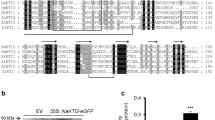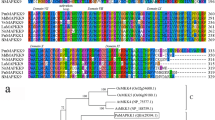Abstract
We identified three Nicotiana attenuata mitogen-activated protein kinase (MAPK) kinases (MAPKKs), NaMEK1, NaSIPKK, and NaNPK2, whose transcript levels were up-regulated in a wild tobacco plant, N. attenuata, after wounding and simulated herbivore attack. A virus-induced gene silencing approach was used to analyze the functions of these three MAPKKs in plant defense against the tobacco hornworm Manduca sexta. NaMEK1 and NaSIPKK influenced the accumulation of the precursor of jasmonic acid (JA), 12-oxo-phytodienoic acid, and silencing NaSIPKK enhanced the levels of wounding- and herbivory-induced JA. In-gel kinase assays indicated that all three MAPKKs were not required for the activation of NaSIPK, an important MAPK in plant responses to wounding and herbivory. However, NaMEK1, NaSIPKK, and NaNPK2 appeared to regulate the levels of trypsin proteinase inhibitor activity. Bioassays revealed that M. sexta larval growth was not impaired on N. attenuata plants silenced in NaMEK1, NaSIPKK, or NaNPK2 expression. Our findings suggest that NaSIPKK is involved in JA biosynthesis after herbivore attack without activating NaSIPK, suggesting that the network of MAPK signaling in N. attenuata's defense responses against herbivore attack is more complicated than previously thought.






Similar content being viewed by others
Abbreviations
- FACs:
-
Fatty acid–amino acid conjugates
- JA:
-
Jasmonic acid
- MAPKK:
-
Mitogen-activated protein kinase kinase
- OPDA:
-
12-oxo-phytodienoic acid
- SIPK:
-
Salicylic acid-induced protein kinase
- TPI:
-
Trypsin proteinase inhibitor
- VIGS:
-
Virus-induced gene silencing
- WIPK:
-
Wound-induced protein kinase
References
Asai T, Tena G, Plotnikova J, Willmann MR, Chiu WL, Gomez-Gomez L, Boller T, Ausubel FM, Sheen J (2002) MAP kinase signalling cascade in Arabidopsis innate immunity. Nature 415:977–983
Baldwin IT, Glawe GA, Zavala JA, Kessler A, Van Dam NM (2003) Ecological costs and benefits correlated with trypsin protease inhibitor production in Nicotiana attenuata. Ecology 84:79–90
Bergmann DC, Lukowitz W, Somerville CR (2004) Stomatal development and pattern controlled by a MAPKK kinase. Science 304:1494–1497
Cardinale F, Meskiene I, Ouaked F, Hirt H (2002) Convergence and divergence of stress-induced mitogen-activated protein kinase signaling pathways at the level of two distinct mitogen-activated protein kinase kinases. Plant Cell 14:703–711
Creelman RA, Mullet JE (1997) Biosynthesis and action of jasmonates in plants. Annu Rev Plant Physiol Plant Mol Biol 48:355–381
Gomi K, Ogawa D, Katou S, Kamada H, Nakajima N, Saji H, Soyano T, Sasabe M, Machida Y, Mitsuhara I, Ohashi Y, Seo S (2005) A mitogen-activated protein kinase NtMPK4 activated by SIPKK is required for jasmonic acid signaling and involved in ozone tolerance via stomatal movement in tobacco. Plant Cell Physiol 46:1902–1914
Halitschke R, Schittko U, Pohnert G, Boland W, Baldwin IT (2001) Molecular interactions between the specialist herbivore Manduca sexta (Lepidoptera, Sphingidae) and its natural host Nicotiana attenuata. III. Fatty acid–amino acid conjugates in herbivore oral secretions are necessary and sufficient for herbivore-specific plant responses. Plant Physiol 125:711–717
Heberle-Bors E, Calderini O, Glab N, Bergounioux C, Wilson C (2001) A novel tobacco mitogen-activated protein (MAP) kinase kinase, NtMEK1, activates the cell cycle-regulated p43(Ntf6) MAP kinase. J Biol Chem 276:18139–18145
Heinrich M, Wu JQ, Baldwin IT (2011) Two mitogen-activated protein kinase kinases, MKK1 and MEK2, are involved in wounding- and specialist lepidopteran herbivore Manduca sexta-induced responses in Nicotiana attenuata. J Exp Bot 62:4355–4365
Howe G (2011) The plant defense hormone jasmonate and its molecular mechanism of action. Phytopathology 101:S230–S230
Howe GA, Jander G (2008) Plant immunity to insect herbivores. Annu Rev Plant Biol 59:41–66
Hua ZM, Yang XC, Fromm ME (2006) Activation of the NaCl- and drought-induced RD29A and RD29B promoters by constitutively active Arabidopsis MAPKK or MAPK proteins (Retracted Article. See vol 29, pg 2253, 2006). Plant Cell Environ 29:1761–1770
Ichimura K, Mizoguchi T, Hayashida N, Seki M, Shinozaki K (1998) Molecular cloning and characterization of three cDNAs encoding putative mitogen-activated protein kinase kinases (MAPKKs) in Arabidopsis thaliana. DNA Res 5:341–348
Kallenbach M, Alagna F, Baldwin IT, Bonaventure G (2010) Nicotiana attenuata SIPK, WIPK, NPR1, and fatty acid–amino acid conjugates participate in the induction of jasmonic acid biosynthesis by affecting early enzymatic steps in the pathway. Plant Physiol 152:96–106
Kaur H, Heinzel N, Schöttner M, Baldwin IT, Galis I (2010) R2R3-NaMYB8 regulates the accumulation of phenylpropanoid–polyamine conjugates, which are essential for local and systemic defense against insect herbivores in Nicotiana attenuata. Plant Physiol 152:1731–1747
Kessler A, Baldwin IT (2001) Defensive function of herbivore-induced plant volatile emissions in nature. Science 291:2141–2144
Kiegerl S, Cardinale F, Siligan C, Gross A, Baudouin E, Liwosz A, Eklof S, Till S, Bogre L, Hirt H, Meskiene I (2000) SIMKK, a mitogen-activated protein kinase (MAPK) kinase, is a specific activator of the salt stress-induced MAPK, SIMK. Plant Cell 12:2247–2258
Kosetsu K, Matsunaga S, Nakagami H, Colcombet J, Sasabe M, Soyano T, Takahashi Y, Hirt H, Machida Y (2010) The MAP kinase MPK4 is required for cytokinesis in Arabidopsis thaliana. Plant Cell 22:3778–3790
Kovtun Y, Chiu WL, Zeng WK, Sheen J (1998) Suppression of auxin signal transduction by a MAPK cascade in higher plants. Nature 395:716–720
Liu Y, Zhou Y, Liu L, Sun L, Li D (2011) In silico identification and evolutionary analysis of plant MAPKK6s. Plant Mol Biol Rep 29:859–865
Lukowitz W, Roeder A, Parmenter D, Somerville C (2004) A MAPKK kinase gene regulates extra-embryonic cell fate in Arabidopsis. Cell 116:109–119
MAPK Group, Ichimura K, Shinozaki K, Tena G, Sheen J, Henry Y, Champion A, Kreis M, Zhang S, Hirt H, Wilson C, Heberle-Bors E, Ellis BE, Morris PC, Innes RW, Ecker JR, Scheel D, Klessig DF, Machida Y, Mundy J, Ohashi Y, Walker JC (2002) Mitogen-activated protein kinase cascades in plants: a new nomenclature. Trends Plant Sci 7:301–308
Meldau S, Wu J, Baldwin IT (2009) Silencing two herbivory-activated MAP kinases, SIPK and WIPK, does not increase Nicotiana attenuata's susceptibility to herbivores in the glasshouse and in nature. New Phytol 181:161–173
Paschold A, Halitschke R, Baldwin IT (2007) Co(i)-ordinating defenses: NaCOI1 mediates herbivore-induced resistance in Nicotiana attenuata and reveals the role of herbivore movement in avoiding defenses. Plant J 51:79–91
Pedley KF, Martin GB (2005) Role of mitogen-activated protein kinases in plant immunity. Curr Opin Plant Biol 8:541–547
Roda A, Halitschke R, Steppuhn A, Baldwin IT (2004) Individual variability in herbivore-specific elicitors from the plant's perspective. Mol Ecol 13:2421–2433
Rodriguez MCS, Petersen M, Mundy J (2010) Mitogen-activated protein kinase signaling in plants. Annu Rev Plant Biol 61:621–649
Rodriguez-Saona CR, Musser RO, Vogel H, Hum-Musser SM, Thaler JS (2010) Molecular, biochemical, and organismal analyses of tomato plants simultaneously attacked by herbivores from two feeding guilds. J Chem Ecol 36:1043–1057
Romeis T (2001) Protein kinases in the plant defence response. Curr Op Plant Biol 4:407–414
Saedler R, Baldwin IT (2004) Virus-induced gene silencing of jasmonate-induced direct defences, nicotine and trypsin proteinase-inhibitors in Nicotiana attenuata. J Exp Bot 55:151–157
Schaller F, Schaller A, Stintzi A (2004) Biosynthesis and metabolism of jasmonates. J Plant Growth Regul 23:179–199
Sheen J, Kovtun Y, Chiu WL, Tena G (2000) Functional analysis of oxidative stress-activated mitogen-activated protein kinase cascade in plants. Proc Natl Acad Sci USA 97:2940–2945
Shibata W, Banno H, Ito Y, Hirano K, Irie K, Usami S, Machida C, Machida Y (1995) A Tobacco protein-kinase, Npk2, has a domain homologous to a domain found in activators of mitogen-activated protein-kinases (Mapkks). Mol Gen Genet 246:401–410
Steppuhn A, Gase K, Krock B, Halitschke R, Baldwin IT (2004) Nicotine's defensive function in nature. PLoS Biol 2:E217
Stintzi A, Weber H, Reymond P, Browse J, Farmer EE (2001) Plant defense in the absence of jasmonic acid: the role of cyclopentenones. Proc Natl Acad Sci USA 98:12837–12842
Tamura K, Dudley J, Nei M, Kumar S (2007) MEGA4: molecular evolutionary genetics analysis (MEGA) software version 4.0. Mol Biol Evol 24:1596–1599
van Dam NM, Horn M, Mares M, Baldwin IT (2001) Ontogeny constrains systemic protease inhibitor response in Nicotiana attenuata. J Chem Ecol 27:547–568
Vick BA, Zimmerman DC (1984) Biosynthesis of jasmonic acid by several plant-species. Plant Physiol 75:458–461
Vick BA, Zimmermann DC (1979) Distribution of a fatty acid cyclase enzyme system in plants. Plant Physiol 64:203–205
von Dahl C, Baldwin IT (2007) Deciphering the role of ethylene in plant–herbivore interactions. J Plant Growth Regul 26:201–209
Wang HC, Ngwenyama N, Liu YD, Walker JC, Zhang SQ (2007) Stomatal development and patterning are regulated by environmentally responsive mitogen-activated protein kinases in Arabidopsis. Plant Cell 19:63–73
Wasternack C (2007) Jasmonates: an update on biosynthesis, signal transduction and action in plant stress response, growth and development. Ann Bot 100:681–697
Wu J, Baldwin IT (2010) New insights into plant responses to the attack from insect herbivores. Annu Rev Genet 44:1–24
Wu J, Hettenhausen C, Meldau S, Baldwin IT (2007) Herbivory rapidly activates MAPK signaling in attacked and unattacked leaf regions but not between leaves of Nicotiana attenuata. Plant Cell 19:1096–1122
Xing Y, Jia WS, Zhang JH (2009) AtMKK1 and AtMPK6 are involved in abscisic acid and sugar signaling in Arabidopsis seed germination. Plant Mol Biol 70:725–736
Xiong LZ, Yang YN (2003) Disease resistance and abiotic stress tolerance in rice are inversely modulated by an abscisic acid-inducible mitogen-activated protein kinase. Plant Cell 15:745–759
Yang KY, Liu Y, Zhang S (2001) Activation of a mitogen-activated protein kinase pathway is involved in disease resistance in tobacco. Proc Natl Acad Sci USA 98:741–746
Yoo SD, Cho YH, Tena G, Xiong Y, Sheen J (2008) Dual control of nuclear EIN3 by bifurcate MAPK cascades in C2H4 signalling. Nature 451:789–U781
Zavala JA, Patankar AG, Gase K, Baldwin IT (2004a) Constitutive and inducible trypsin proteinase inhibitor production incurs large fitness costs in Nicotiana attenuata. Proc Natl Acad Sci USA 101:1607–1612
Zavala JA, Patankar AG, Gase K, Hui D, Baldwin IT (2004b) Manipulation of endogenous trypsin proteinase inhibitor production in Nicotiana attenuata demonstrates their function as antiherbivore defenses. Plant Physiol 134:1181–1190
Zhang S, Klessig DF (1997) Salicylic acid activates a 48-kD MAP kinase in tobacco. Plant Cell 9:809–824
Zhang S, Liu Y (2001) Activation of salicylic acid-induced protein kinase, a mitogen-activated protein kinase, induces multiple defense responses in tobacco. Plant Cell 13:1877–1889
Zhang JH, Sun LW, Liu LL, Lian J, An SL, Wang X, Zhang J, Jin JL, Li SY, Xi JH (2010) Proteomic analysis of interactions between the generalist herbivore Spodoptera exigua (Lepidoptera: Noctuidae) and Arabidopsis thaliana. Plant Mol Biol Rep 28:324–333
Acknowledgements
We thank the Max Planck Society for financial support.
Author information
Authors and Affiliations
Corresponding author
Additional information
This work was funded by the Max Planck Society.
Electronic Supplementary Material
Below is the link to the electronic supplementary material.
ESM 1
(DOC 1180 kb)
Rights and permissions
About this article
Cite this article
Heinrich, M., Baldwin, I.T. & Wu, J. Three MAPK Kinases, MEK1, SIPKK, and NPK2, are not Involved in Activation of SIPK after Wounding and Herbivore Feeding but Important for Accumulation of Trypsin Proteinase Inhibitors. Plant Mol Biol Rep 30, 731–740 (2012). https://doi.org/10.1007/s11105-011-0388-0
Published:
Issue Date:
DOI: https://doi.org/10.1007/s11105-011-0388-0




